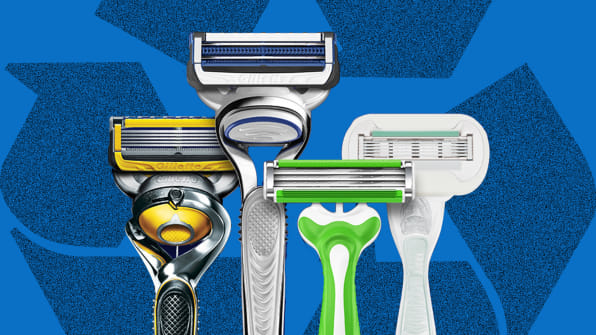You want to look great while respecting the planet, right?
April Long Mar 15, 2019
Beauty products can have some ugly effects on the environment, choking landfills with trash and polluting our waterways. Thankfully, companies large and small are stepping up their sustainability game, prioritizing the responsible sourcing of ingredients, implementing earth-friendly manufacturing processes, and experimenting with inventive recycling programs. But we all have a role to play. Even the tiniest gestures make an impact, right down to the number of styling products we use in our hair. Here, how you can help.
The issue: squandering our resources.
The way plant ingredients in your creams and shampoos are farmed affects local communities and ecosystems—and a product’s overall carbon footprint. One of the most egregious examples is palm oil, whose derivatives appear in a whopping 70 percent of cosmetics. Indiscriminate building of palm oil plantations in Indonesia and Malaysia has decimated rainforests, and research indicates that deforestation releases more carbon dioxide into the atmosphere than all the cars and trucks in the world combined. Also, most personal care products use water in manufacturing and as a main ingredient—and the availability of clean, drinkable water is expected to nose-dive by 2050, thanks to climate change, pollution, and increased demand.
What’s being done?
Mega-companies are making major changes.
L’Oréal, which has committed to being deforestation-free by 2020, and
Estée Lauder are working closely with the global nonprofit Roundtable on Sustainable Palm Oil to ensure that their cultivation methods and sourcing have minimal negative environmental impact.
So is
Unilever—the parent company of
Dove,
St. Ives, and
Pond’s—which released its entire supply chain to the public, promising to source all its palm oil sustainably. That’s a big deal, given that Unilever brands go through more than a million metric tons of the stuff per year. In addition, Unilever and L’Oréal are putting resource efficiency front and center, devising innovative ways to use less water in production and with products themselves (low-water-use shampoo, fast-rinse conditioners).
One of the most exciting developments, though, is brought to us by biotechnology, which companies are using to create environmentally responsible ingredients. The skincare line
Biossance makes its squalane, a naturally occurring oil traditionally derived from shark livers or olives, from renewable sugarcane, and the brand
Algenist’s key anti-agers, alguronic acid and microalgae oil, come from sustainable algae.
What can you do?
At home is start by being mindful of your water use. Turn off the shower while shaving, and skip a shampoo occasionally. If you want to go full-on farm-to-face, choose green beauty standouts like
Jurlique,
Juice Beauty,
Dr. Hauschka, and
Tata Harper—they all grow botanicals on their own farms. Otherwise, look for labels such as Ecocert, which guarantees the use of renewable ingredients.
Seed Phytonutrients founder Shane Wolf, who worked to develop the first-ever shower-friendly paper bottles, made from 100 percent recycled material and used for the brand’s shampoo, conditioners, cleansers, and hand wash. More than 60 percent of paper is recycled, while less than 10 percent of plastic is, “Any move away from plastic toward paper is a move in the right direction,” says Wolf. And hidden inside each bottle is a packet of seeds, which can be planted to grow heirloom herbs.
The issue: emissions and pollution.
Global fossil fuel–related emissions of carbon dioxide reached an estimated record high of 37.1 billion metric tons in 2018, which is putting us on course for a very hot and smoggy planet. Consumers—that’s us!—are calling for accountability and action, and brands are responding.
What’s being done?
The big guys are effecting big change. Several items in
Garnier’s SkinActive linehave earned Cradle to Cradle certification, which measures environmental impact over the life of a product, and parent company L’Oréal USA has pledged to achieve carbon neutrality for its plants and distribution centers this year by switching to renewable energy. (Fun fact: The
Maybelline Great Lash mascaras sold in America are made with 100 percent renewable electricity.)
And remember those plastic microbeads from face scrubs and cleansers that were turning up in lakes and oceans (and fish bellies) a few years ago? They’ve been banned from rinse-off personal care products in the U.S. Small brands are making a difference, too. Most of Tata Harper’s packaging is made from easily recyclable glass (more than one ton of natural resources, like sand or limestone, is saved for every ton of glass recycled), and the plastic used for its tubes is derived from corn rather than petroleum.
What can you do?
Try an eco-audit of your own daily beauty regimen, assessing the number of products you buy and how much waste is produced as a result. The Nature Conservatory’s carbon calculator (
nature.org) helps you determine your footprint, then offers tips on what you can do to decrease it. One thing you shouldn’t do: Clean your face with a non-biodegradable wet wipe—and you really shouldn’t flush it down the toilet. Why? Just Google “fatberg.”
Former fragrance exec Marcella Cacci launched the skincare line
One Ocean Beauty in 2018 with a simple mission: to help protect the health of the oceans. The brand harnesses “blue biotechnology,” which involves reproducing marine extracts from algae, kelp, and seaweed in the lab rather than harvesting them from the sea. This means there’s no impact on the ocean’s natural bounty. “We never hurt the biodiversity,” says Cacci, who adds that the brand has also donated $250,000 to Oceana, the largest global nonprofit focused solely on ocean conservation.
The issue: waste.
A staggering eight million metric tons of plastic ends up in the ocean every year, with countless pieces of bottle caps and straws in the Great Pacific Garbage Patch, which is actually two large masses between Japan and the U.S. West Coast. If current trends continue, it’s predicted that by 2050, plastic will outweigh fish in our oceans, and 12 billion metric tons of it will sit in landfills. The beauty industry, which produces billions of plastic packaging units annually, has a lot to answer for.
What’s being done?
Plenty! Unilever and L’Oréal have committed to using 100 percent recyclable or compostable packaging by 2025;
Procter & Gamble, the übercompany behind
Pantene,
Head & Shoulders, and
Herbal Essences, has pledged the same by 2030. Beginning this year, haircare brand Kevin Murphy is going all in, sourcing its packaging from reclaimed ocean plastic, a move that will save more than 360 tons of new plastic annually. Since 2011, Garnier has partnered with TerraCycle to tackle previously unrecyclable beauty packaging, diverting approximately 11.2 million empties from landfills. And at the World Economic Forum in January, a consortium of brands, including
REN Clean Skincare and the Body Shop, announced participation in
Loop, a shopping program that will offer products in durable packaging that can be returned, sanitized, and reused (like old-school milk bottles). It’s set to launch in the New York City area and France this spring.
What can you do?
Excuse us for shouting, but...RECYCLE! According to the Environmental Protection Agency, recycling just ten plastic bottles saves enough energy to power a laptop for more than 25 hours. Since products used in the bathroom tend to have a low recycling rate (people typically keep their bins in the kitchen), make it easier for yourself by keeping a ready receptacle next to the shower. Need more incentive?
Kiehl’s,
Lush, and
MAC offer freebies when you bring in empties, and others, including
Origins and
Tenoverten (with nail salons in New York City, Los Angeles, and Austin), will accept containers from other brands as well. When shopping, gravitate toward items without excess packaging (or none at all—Lush’s new Naked concept stores offer bath products, haircare in bar form, and facial soaps with no packaging whatsoever), or look for a label that specifies 100 percent recycled content.
Since its inception in 2013,
Beautycounter has become one of America’s most trusted sources for cleaner skincare and makeup. Founder Gregg Renfrew’s top goal is ingredient safety (the company’s do-not-use list includes approximately 1,500 chemicals), and she views sustainability as intrinsically linked to that mission. “We’re committed to making decisions that are based on scientific research, but given the large data gaps around safety and sustainability, it’s extremely complicated,” Renfrew says.
To help close those gaps, Beautycounter partners with researchers and universities, and has screened more than 1,000 ingredients for their effects on our health and the environment. Meanwhile, Renfrew is advocating for increased federal oversight to help clean up cosmetics: She and her team have met repeatedly with D.C. lawmakers to lobby for legislation like the Personal Care Products Safety Act, which would give the FDA the power to, among other things, regulate potentially harmful ingredients.
The issue: animal testing.
This practice may not be directly related to the environment, but should concern anyone who cares about our fellow living creatures. While the U.S. is inching toward a ban (California will prohibit the sale of cosmetics that have been tested on animals starting next year, and New York and Hawaii have introduced similar legislation), many companies have implemented their own prohibitions on testing. The EU has forbidden it outright, but it’s actually still required for foreign products sold in China. For an international corporation that wants to do business there, this is a problem.
What’s being done?
Multinationals and smaller brands alike are pushing for change in China and countries that still permit animal testing; in 2018, the Body Shop and Cruelty Free International (CFI) brought a petition with 8.3 million signatures they’d gathered worldwide to the UN, calling for a global ban.
What can you do?
Check labels for a little rabbit; it signifies that CFI’s Leaping Bunny program has certified a product as cruelty-free. If in doubt, check Leaping Bunny’s website or head to PETA to find the rigorously vetted
Beauty Without Bunnies list, which ensures that neither brands nor their ingredient suppliers are spritzing hairspray in any animal’s eyes.





 Enlarge
Enlarge